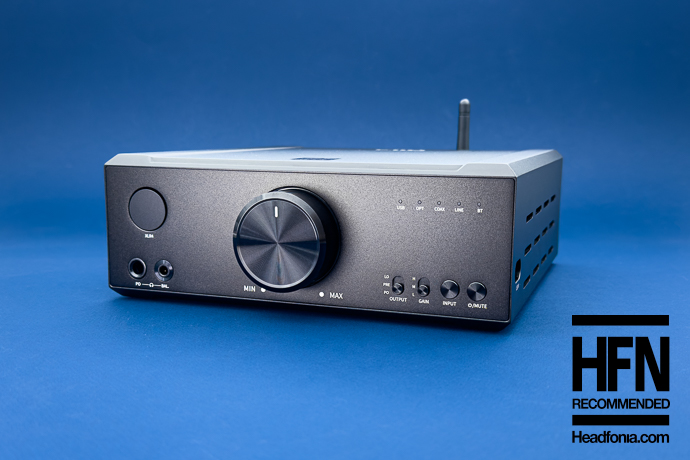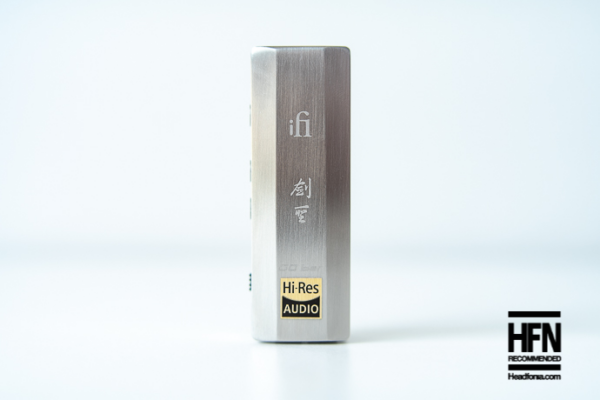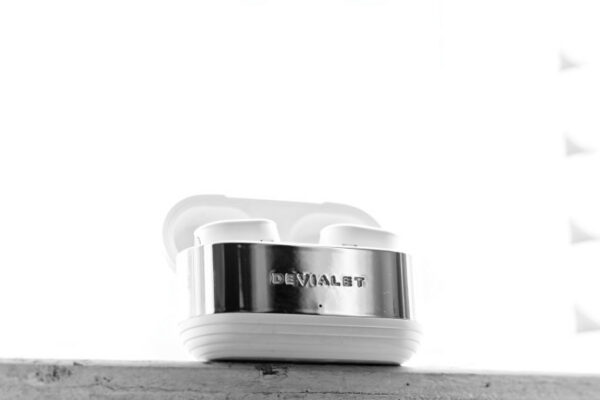If Google is showing you this page directly, click here to go to the start of the article.
Controls & Operation
This paragraph is shared between the devices, as the K9 AKM has the same controls as the K9 and the K9 Pro ESS. As you know, the K9 does not have a screen, and frankly, as I like its design very much, I did not look for a screen during the three months of play. The entire interface of the K9 AKM consists of LEDs, buttons, and switches on the front panel. The five status LEDs on the top right of the front panel indicate the unit’s active input.
There is also an integrated RGB LED around the volume control.
It is color-coded and provides various information, including power status, pairing status, and the active sample rate or file type during playback. At the bottom right of the front panel are two switches and two buttons. From left to right there is an output selector, a gain selector, an input selector and finally a button that doubles as a power and mute button. A long press switches the unit off, while a single press mutes all sound.
Controlling the unit is fairly straightforward. The positioning of the buttons is easy to remember, and it takes less than 10 minutes to get to grips with the controls. As the K9 AKM is an all-in-one device, it can be used in many different ways. The unit has dedicated DAC, PRE, and PO modes. In other words, the DAC can feed your active monitors in PRE mode, or you can use DAC mode with your power amplifier and bypass the THX modules.
While the DAC mode is volume fixed, the PRE mode is volume variable. Finally, PO mode activates the headphone outputs on the front panel. As the unit has a fully balanced architecture, it will be advantageous to use the balanced outputs if you have proper terminations. Furthermore, the output impedance of the unit is quite low, making it ideal for use with low-impedance multi-driver IEMs. FiiO has designed this unit to be used as a jack-of-all-trades in all sorts of setups, and they have done an excellent job.
The K9 can be controlled via the FiiO Control app, which is available for both iOS and Android platforms. The app offers a lot of options. Let’s take a closer look.
There are many settings available, and I will try to mention them in this paragraph. In the app, you can change the pattern of the status indicators on the volume control, change the Bluetooth codec priority, or assign a single codec, such as LDAC, to be the only active codec. You can also use the app to select a new input source. There is also a built-in EQ in the app.
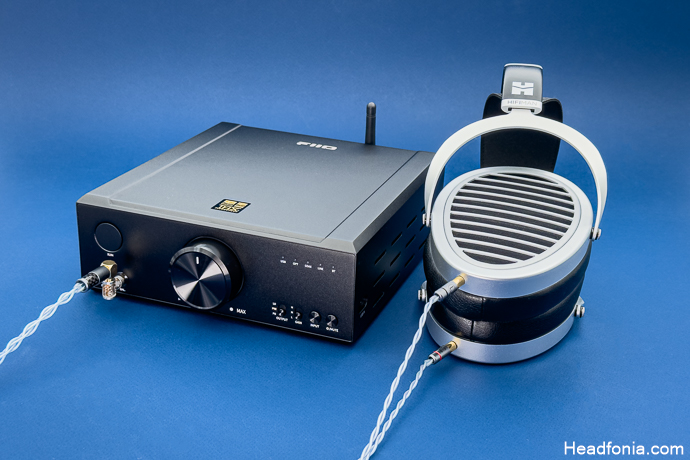
Apart from that, we also have a few system controls within the app. We have the ability to clear the pairing list and update the firmware on the device both via local files and OTA. We can also use the app to revert to the factory defaults if we encounter any problems during operation. As for the audio settings, we have a channel balance bar and 3 DAC filters to choose from.
In this final section, we’ll look at the wired and wireless decoding capabilities of the K9 AKM. The unit is equipped with the latest generation XMOS XU308 USB controller. Thanks to the new controller, it can decode PCM up to 32bit-768kHz and DSD up to DSD512 natively over USB. The K9 and K9 AKM use a superior USB chip compared to the K9 Pro ESS, which uses the XU208. As for Bluetooth, the device is equipped with the same top-of-the-range Bluetooth 5.1 chipset from Qualcomm, the trusty QCC5124. The K9 AKM supports the AAC, SBC, AptX LL, AptX HD & LDAC codecs. LDAC works well, even when we force-feed it a constant 990kbps (max) of data via the Android platform’s developer options.
Comparative DAC Performance
The K9, the K9 Pro ESS, and the K9 AKM are the K9 series that I have had the privilege of testing for a long time. They impressed me a lot, especially non-pro variants, with their excellent price-to-performance ratio. Let’s start by evaluating the DAC performance of the unit by switching to DAC-only mode and pairing it with LSR308PMKII active monitors. LSRs are neutral-warm reference monitors with a linear response in the right acoustic environment. I’ll also be testing it with Focal Alpha 80 active monitors. No double amping or pre for this test; K9 AKM is directly connected to monitors, and monitors handle the volume control via their pot on the back. My first impressions were positive about the AKM, as it seems it has a slightly smoother tonality with slightly more precise imaging compared to the K9 regular. The gap between the K9 and the K9 Pro seems even smaller with the K9 AKM, and I take this as a huge win for my budget and yours.
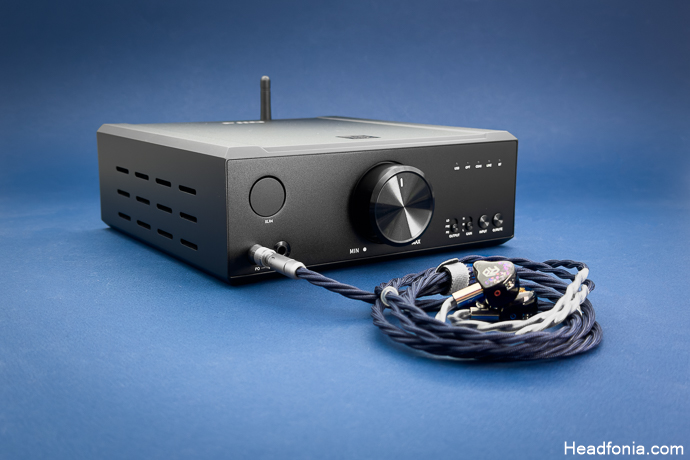
The signature is neutral-warm with both monitors, and the detail retrieval is impressive. The highs feel a tad smoother, with a similar resolution that I liked with the K9 Pro ESS. The vocals are slightly more engaging, and there is more air between the instruments. The sound feels slightly more effortless, but I struggled with the differences above these. Neither of my active monitors is flat-sounding source-busters, so I paired the DACs to my Geshelli AMP, which is as linear as AMPs get, to spot more differences. Volume-matched A-B’ing confirmed my thoughts above; the AKM version feels effortless and sounds more relaxed with the same amount of clarity, resolution, and detail. It is a slightly different taste versus the more clinical K9 and the K9 ESS.
The K9 Pro ESS seems to be the winner, PRaT-wise at least, with sharper attack and decay, with more accentuated notes. Hi-hats feel more energetic and sharper with the K9 and K9 Pro ESS, with the K9 Pro ESS front running the pack in resolution. The AKM, on the other hand, is reproducing these hi-hats and crash splashes more naturally. I liked the presentation of the AKM the most among the three. I may be repeating myself, but it feels effortless and easy yet detailed simultaneously. There’s a noticeable imaging boost versus the K9 regular, and instruments have more space to breathe. If you ask me which I prefer, I’d say the K9 AKM. I think it offers the best value out of the three.
Comparative DAC & AMP Performance
With the Hifiman Ananda Nano, The FiiO K9 AKM sounds clean, effortless, and musical. This pairing sounds excellent, as both units are highlights in their price brackets. The Ananda Nano benefits from K9 AKM’s excellent technical capability. The Nano loves extra oomph, and the K9 AKM has plenty of juice to spare. The background, similar to the K9, is pitch-black. One difference I noticed with this pair is that Nano’s treble isn’t as sharp as it is with the K9 Pro ESS or the K9, at the top octave. PRaT-wise, K9 AKM feels on par with the K9, maybe slightly faster. Stage-wise, the K9 AKM is a victor over the K9, with a more airy, slightly wider stage with better depth. The Ananda Nano is a great tool when it comes to imaging, and I feel like the K9 AKM is catching up with the K9 Pro ESS in this regard. Both units layer instruments precisely, and it is easy to pinpoint the location of the individual elements within the stage. Compared to the K9, the mid-bass of the AKM feels ever so slightly more emphasized. The subs feel slightly tidier, and the upper mids feel more effortless and breathy. Like the rest of the K series, the K9 AKM is capable of producing deep and impactful lows, depending on the pairing.
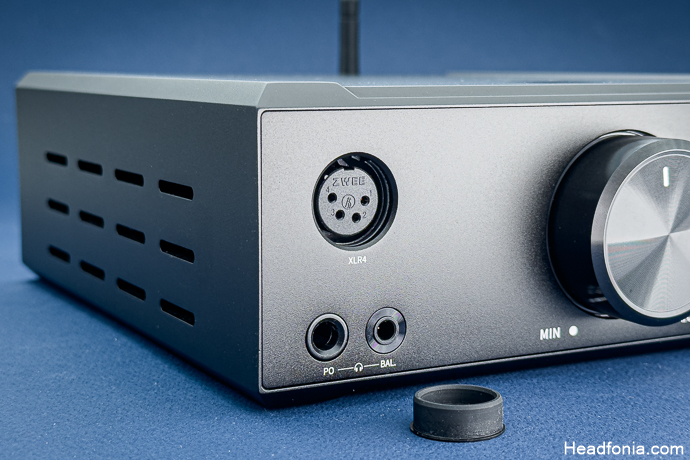
The midrange of the K9 AKM feels very clean throughout the entire region, like the K9 and K9 ESS. Compared to the K9, the AKM reproduces instruments, especially natural instruments more organically with more weight and increased musicality. The vocals feel slightly more coherent and articulate, especially with mid to high-end IEMs.
I mentioned in my K9 review that if the recording that you are playing is bad, K9’ll show it to you during the reproduction and that the K9 does not feel clinical but it is not too far from there. The AKM, on the other hand, feels more forgiving towards such recordings. The AKM places the stage further away from you compared to the rest of the K9 series, which is a positive in my book, as K9 can sound a bit “in-your-face” with poorly recorded tracks.
I mentioned that while I find the K9’s treble reproduction quite good, the level of detail may be tiring for some treble-sensitive audiophiles out there. The K9 AKM has a more delicate treble with the same resolution, so it may be better for those people to choose the AKM over the regular version. I find the K9 AKM’s treble resolving and silky.
Wireless Performance
This section is shared between the K9/K9 AKM. My thoughts on the wireless performance are identical.
The K9 utilizes the same wireless chipset and implementation as the K9 Pro ESS, using Qualcomm’s QCC5124. This chipset has garnered critical acclaim and is widely used across various devices. In our experience, it ranks as one of the most stable chipsets available. Streaming at 24-96kHz LDAC with the K9 is both simple and reliable. While the sound quality is praiseworthy, it doesn’t quite match up to a wired connection. This loss in detail is easily discernible when using a high-quality pair of IEMs or headphones.
When it comes to using the K9 with active speakers, the difference in sound quality becomes subtler and less noticeable. However, it’s important to note that the SQ is constrained by LDAC’s 990kbps cap, and many phones struggle to maintain this constant bitrate. In our tests, we successfully streamed at a consistent 990kbps, and the signal remained stable even when passing through two thick concrete walls. This suggests that the K9 offers a killer performance when it comes to the Bluetooth coverage range.
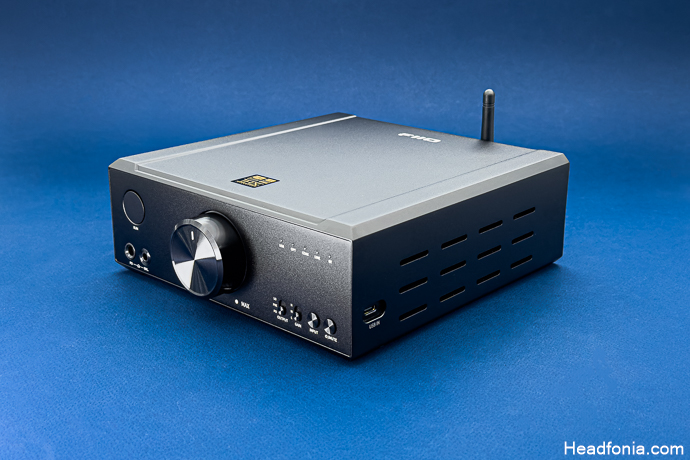
Last Words
The FiiO K9 AKM, retailing at $529.99, is an example of a successful continuation and evolution of the K9 series, offering a sound investment for both new and seasoned audiophiles. It combines quality construction with cutting-edge technology to provide a versatile, all-in-one audio solution. Ideal for those who prefer a neutral-warm DAC/AMP, the K9 AKM showcases FiiO’s expertise in the competitive mid-range DAC/AMP market.
If you’re in the market for a feature-rich desktop DAC & AMP around the $500 range, I highly recommend giving the FiiO K9 AKM a try. It’s well worth it. The K9 AKM is replacing the K9 in our Best Gear / Recommended Buy Guide.

Summary
Pros:
+ Musical, balanced and clean sound signature
+ Excellent price to performance ratio
+ Excellent feature-set
+ Excellent build quality
Cons:
– Heavy
– Huge
Page 1: FiiO, K9 AKM, Packaging & Accessories, Design & Build Quality, Technology & Audio Circuitry,
Page 2: Controls & Operation, Comparative DAC Performance, Comparative DAC/AMP Performance, Wireless Performance, Last Words





